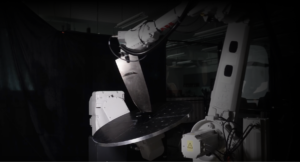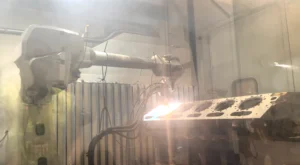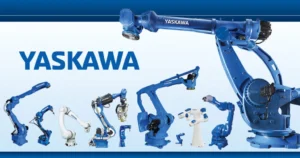table of contents
- Heading 1
- Heading 1
- Heading 1
- Introduction
- The Allure of Fully Autonomous Manufacturing
- Applications Beneficial for Autonomous Manufacturing: Abrasive Blasting
- The Challenges of Going Fully Autonomous
- Augmentus: Revolutionizing Autonomous Manufacturing
- How Augmentus' Closed-loop Automation System Can Achieve Autonomous Manufacturing
- Conclusion
share this
Introduction
Fully autonomous manufacturing has long been a coveted goal in the aerospace industry and beyond. The promise of streamlined operations, reduced labor costs, and unparalleled precision makes it an enticing prospect. However, the journey towards achieving this dream has been fraught with challenges, especially when dealing with complex components such as aerospace turbine blade parts. These parts, with their intricate and curved surfaces, have historically demanded extensive programming and skilled labor to manufacture accurately. This article explores why fully autonomous manufacturing is so desirable, the hurdles that have made it difficult, and how Augmentus is revolutionizing the process.
The Allure of Fully Autonomous Manufacturing
The concept of fully autonomous manufacturing appeals to manufacturers for several compelling reasons:
- Efficiency and Productivity: Autonomous systems can operate 24/7 without breaks, significantly boosting productivity and efficiency. This constant operation can lead to higher output rates and faster turnaround times, crucial in competitive industries like aerospace.
- Consistency and Quality: Human error is a major factor in manufacturing defects. Autonomous systems, governed by precise algorithms and sensors, can consistently produce high-quality parts with minimal variations, ensuring adherence to stringent aerospace standards.
- Cost Savings: Although the initial investment in autonomous systems can be high, the long-term savings in labor costs, reduced waste, and higher efficiency can lead to substantial financial benefits.
- Flexibility and Scalability: Modern autonomous systems can quickly adapt to different tasks and production scales. This flexibility is particularly beneficial in industries where customization and small-batch production are common.
Applications Beneficial for Autonomous Manufacturing: Abrasive Blasting
One of the primary applications where fully autonomous manufacturing can be immensely beneficial is in abrasive blasting (such as sandblasting) processes. These techniques are essential in various industries, including aerospace, to clean or prepare surfaces for coating. The ability to perform these processes autonomously not only enhances efficiency but also ensures consistent and high-quality outcomes. Autonomous systems can handle the variability and precision required for these applications, making them ideal for industries that demand stringent quality control.
The Challenges of Going Fully Autonomous
Despite its benefits, fully autonomous manufacturing has been challenging to implement, especially for complex components. Several factors contribute to these difficulties:
- Complex Geometries: Aerospace turbine blades, with their intricate curves and surfaces, are common within metal and composite processing. Programming robots to handle such complexity has traditionally been a time-consuming and error-prone process.
- High Precision Requirements: Aerospace components must meet extremely tight tolerances. Achieving this level of precision autonomously requires advanced sensors, software, and robotic capabilities.
- Integration with Existing Systems: Implementing fully autonomous systems often requires significant changes to existing manufacturing setups. This integration can be complex and costly, deterring many companies from pursuing it.
Augmentus: Revolutionizing Autonomous Manufacturing
Augmentus has tackled these challenges head-on, enabling fully autonomous processes of complex aerospace turbine blade parts without the need for extensive programming.
Here’s how:
- Advanced 3D Vision and AI: Augmentus employs state-of-the-art 3D vision technology combined with AI algorithms to accurately map and understand the complex geometries of turbine blade parts. This technology allows the system to autonomously generate tool paths that ensure precise process.
- No Programming Required: One of the most significant innovations from Augmentus is the elimination of manual programming. Traditional robotic systems require detailed programming for each task, but Augmentus’ solution can automatically generate the necessary instructions, drastically reducing setup times and human intervention.
- Post-processed Inspection: Augmentus Vision is able to inspect parts to ensure outcome is satisfactory and then auto generates robot motion on areas that have failed process requirements. The system can repeat itself until satisfactory outcome is achieved. This capability ensures that any variations outside of process tolerance are immediately corrected, maintaining high quality and precision, without any manual intervention.
- Seamless Integration: Augmentus designs its solutions to integrate smoothly with existing manufacturing setups. This approach minimizes disruption and allows companies to gradually transition to fully autonomous systems.
How Augmentus’ Closed-loop Automation System Can Achieve Autonomous Manufacturing
To achieve a fully autonomous process, operators only need to create the master program once, which takes just minutes. After that, subsequent parts can be processed fully autonomously, with no additional programming required.
Step 1: Scan

Figure 1: Turbine blade undergoing scanning
Create digital twin of the working environment using the Augmentus Vision system. Capturing the 3D profile of the work piece with high precision aids in accurately defining the work area.
Step 2: Plan
For the first time that the operator has to build a master program, it can be done in minutes.
Simply select the surfaces, and the system will automatically detect the surfaces to be worked on. Process parameters can be effortlessly adjusted and customized according to customer needs.

Figure 2: Augmentus’ AutoPath software – users can select area by tapping. Following this, users can adjust process parameters at any waypoint for optimal results.
Key parameters essential include:
Step distance:
This refers to the distance the robot moves between application passes. A correct step distance ensures uniform coverage and thickness of the powder coating. If the step distance is too great, it can lead to inadequate coverage and bare spots. Conversely, too small a distance can result in excessive coating, leading to waste and potentially runs or sags in the finish.
Density:
This parameter controls the amount of powder that is applied to the surface per unit area. Proper density settings are vital to achieve the desired coating thickness and quality. Inadequate density can result in poor surface protection, while too much density can cause the coating to be too thick, which not only wastes material but may also affect the drying and curing processes.
Offset:
Offset refers to the distance between the spray gun and the surface being coated. It is critical for achieving optimal adhesion and uniformity of the powder coating. An incorrect offset can lead to uneven coating thickness, poor adhesion, or overspray, which results in material wastage and potential contamination of the workspace.
Speed:
The speed at which the robot moves affects the application rate and the overall quality of the coating. Faster speeds can lead to thinner coatings, which may be insufficient for proper surface coverage. Slower speeds can result in too thick a coating, increasing material costs and potentially affecting the curing process.
Wait:
The wait time is the delay programmed into the robot’s operation to allow for processes such as curing or drying between layers or after a complete pass. Adequate wait times are crucial to ensure that each layer of coating has sufficient time to achieve the necessary chemical and physical properties before the next stage of the process. This affects the durability and finish quality of the coating.
Step 3: Simulate

Figure 3: Simulation of the entire process – ensures all paths are correct before deployment.
The system also facilitates simulation of robot paths, enabling meticulous planning without interrupting actual process. Simulation allows for visualization and fine-tuning of robot paths, and ensuring there are no collision, reachability and singularity errors.
Step 4: Deploy

Figure 4: Script Generation by Augmentus System – Automatically creates scripts based on the selected robot and tools, no coding required.
After simulation is completed, the robot script and codes are generated specific to robot model, end-effector, sensor and peripherals. Script is transferred seamlessly to robot controller via FTP or USB.
Step 5: Inspection & Adapt
With the master program established, the 3D scanner continuously inspects the workpiece and provides feedback to the robot. The system will automatically generate robot motions for areas that fail to meet process requirements on post-processed parts. Inspection and localized processing will repeat until a satisfactory outcome is achieved.
Conclusion
At Augmentus, we are proud to be at the forefront of the autonomous manufacturing revolution. By overcoming the traditional challenges associated with complex geometries and high precision requirements, we are paving the way for a new era in manufacturing. As our technology continues to evolve, we anticipate even broader adoption and greater advancements in the pursuit of fully autonomous manufacturing. We are excited to be part of this journey and look forward to helping more manufacturers achieve their autonomy goals.
Ready to see our technology in action? Schedule a demo with us today and discover how Augmentus can transform your manufacturing processes.



